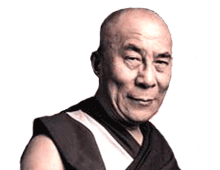-
- UIIC ASSISTANT RECRUITMENT
- CDS Exam
- Territorial Army Officers Exam
- INDIAN NAVY SAILORS
- SBI SME Exam
- NDA Exam
- CTET Exam
- SSC MTS Exam
- SSC CGL Exam
- SSC CHSL Exam
- IBPS SO CWE Exam
- SSC SI CAPF Exam
- SSC Constable GD Exam
- SBI SO Exam
- SSC Stenographer Exam
- SBI PO Exam
- SBI Clerk Exam
- RRB NTPC Exam
- IBPS RRB CWE Exam
- IBPS PO CWE Exam
- IBPS Clerk CWE Exam
- Delhi Police Exam

His Holiness the Fourteenth Dalai Lama, Tenzin Gyatso, was born on July 6, 1935 to a peasant family in the small village of Taktser in north-eastern Tibet and got recognition at the age of two as the reincarnation of His predecessor, the Thirteenth Dalai Lama. The Dalai Lamas are the manifestations of the Buddha of Compassion, who chose to take rebirth to serve humanity. Dalai Lama means Ocean of Wisdom; Tibetans normally refer to His Holiness as Yizhin Norbu, the Wish-Fulfilling Gem, or simply Kundun, the Presence.Gates attended public elementary school and the private Lakeside School. There, he discovered his interest in software and began programming computers at the age of 13.
When the Thirteenth Dalai Lama died in 1935, the Tibetan Government had not simply to appoint a successor, but to discover the child in whom the Buddha of Compassion would incarnate: the child need not have been born just at the death of His predecessor, or even very soon thereafter. As before, there would be signs of where to search. For example, when the Thirteenth Dalai Lama's body was laid in a shrine facing south, His head turned to the east twice, and to the east of his shrine a great fungus appeared on the east side of a pillar of well-seasoned wood. The Regent of Tibet went to the sacred lake of Lhamoe Lhatso, where Tibetans have seen visions of the future. There he saw, among other things, a monastery with roofs of green jade and gold and a house with turquoise tiles. A detailed description of the entire vision was written down and kept a strict secret.
In 1937 high lamas and dignitaries were sent throughout Tibet to search for the place seen in the vision. Those heading east were led by Lama Kewtsang Rinpoche of Sera Monastery. In Takster they found such a place and went to the house, with Kewtsang Rinpoche disguised as a servant and a junior monk posing as the leader. The Rinpoche was wearing a rosary of the Thirteenth Dalai Lama and the little boy, recognizing it, demanded that it be given to him. This was promised, if the child could guess who the wearer was. The reply was Sera aga (in the local dialect, a monk of Sera). The boy was also able to tell who the real leader and servant were. After many further tests, the Dalai Lama was enthroned in 1940.
In 1950, at the age of sixteen and still facing nine more years of intensive religious education, His Holiness had to assume full political power when China invaded Tibet. In March of 1959, during the national uprising of the Tibetan people against Chinese military occupation, He went into exile. Since then He has lived in the Himalayan foothills in Dharamsala, India, the seat of the Tibetan Government-in-exile, a constitutional democracy since 1963. Dharamsala, aptly known as Little Lhasa, also has cultural and educational institutions and serves as a "capital-in-exile" for 130,000 Tibetan refugees living mainly in India; others are in Nepal, Switzerland, the UK, the United States, Canada and thirty other countries. In the past decade, the Dalai Lama has tried to open dialogue with the Chinese. He proposed a Five-Point Peace Plan in 1987-88, which would also stabilize the entire Asian region and which has drawn widespread praise from statesmen and legislative bodies around the world, but the Chinese have yet to enter into negotiations.
Meanwhile, the Fourteenth Dalai Lama, unlike His predecessors who never came to the West, continues His world-wide travels, eloquently speaking in favour of ecumenical understanding, kindness and compassion, respect for the environment and, above all, world peace.

